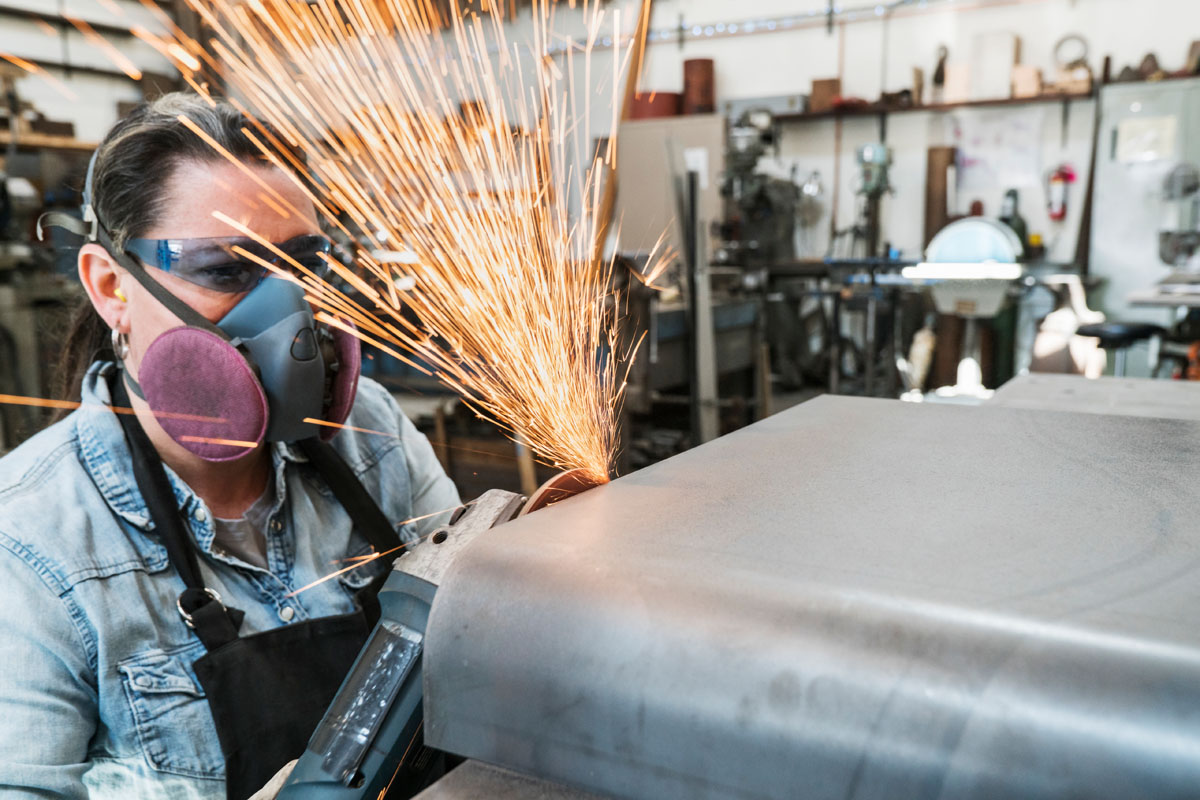Welding and fabrication are terms you frequently hear if you work in the metalworking industry. Although the terms fabrication and welding are sometimes used interchangeably, they are not the same thing.
What makes fabrication different from welding? While welding is a single step in the fabrication process, metal fabrication is the entire metal manufacturing process. Welding is always a component of fabrication, even though fabrication may involve welding. Metal components can be fabricated without welding, but welding unquestionably results in the fabrication of your final product.
The welding trade and the fabrication process require a variety of skill sets. Both metal fabricators and welders are highly skilled artisans who frequently perform similar duties in the metal manufacturing sector as a whole.
What are fabrication and welding?
The most basic definition of welding is the process of joining metal components. Although glass and thermoplastics can also be welded, most people think of welding in relation to metals. Metals are combined by welders during the fabrication process.
The broader set of operations required to create metal goods is referred to as fabrication. It covers every step of the production process, from product design to final completion. In order to transform a product concept into a metallic reality, fabricators must employ a variety of intricate processes. Welding is one of those highly skilled processes.
A large number of metal fabricators are skilled and qualified welders as well. A lot of welders are also fabricators. Depending on the facility and the particular task being performed, a person’s role as a fabricator or welder may vary. For example, your job may involve cutting, bending, shaping, and finishing your project in addition to your primary responsibility as a welder. Or you work as a metal fabricator for a living and occasionally weld to finish the job.
Welders and metal fabricators work in a huge American industry. The U.S. metal fabrication industry employs about 1.484 million people, according to the US Bureau of Labor Statistics. A lot of them work as welders. Additionally, machinists, millwrights, cutters, benders, and assemblers are skilled workers in the fabrication industry. Next are those who oversee, plan, and engineer fabrication projects.
The fabrication industries are expected to have a prosperous future, according to analysts. Despite the present tariffs on steel and other metals, Chris Kuehl, an economic analyst, predicts that the metal fabrication sector will grow at a rate of between 2.7 and 3.4 percent, which is the same as the GDP of the United States. If you work as a welder or metal fabricator, this is good news.
The Process of Metal Fabrication
A process that starts with an idea and ends with a completed product that is prepared for installation and use includes welding as just one step. The process of fabricating any part or component must proceed logically and linearly from beginning to end.
The goal is in mind when the metal fabrication process starts. Every material used in a project has a specific function that is planned and taken into consideration. Every fabrication project involves a number of steps, and the success of each one depends on the others. The primary components of the metal fabrication process are as follows:
1. The bidding
The work being bid on or tendered is the first step in any project. The end-user will now have a framed scope of work that outlines the purpose of the product and the quantity needed. This could be a general idea applied to a truck trailer, or it could be a very specific part used in a very complex industry like aerospace.
Businesses putting in bids for metal fabrication projects will evaluate their capacity to complete the task given their available resources. Some fabrication companies can handle every aspect of the scope of work in-house, whereas other businesses may need to hire outside contractors for specialized services like welding.
The quality and accuracy of bids depend on the information that the client gives the prime contractor. In order to obtain the best-priced work with the highest-quality manufacturing, competitive bidding between various metal fabrication companies is typically an adversarial exercise that backfires.
Nowadays, the design/build structure is used in a lot of fabricator and client agreements.
2. Organizing
This stage of fabrication is crucial. Even though no actual metal cutting, bending, or welding is taking place just yet, the time and effort invested in project planning can make or break a project’s success. The metal fabrication process is no exception to the adage that “failing to plan is planning to fail.”
Planning lays the groundwork for subsequent stages of the procedure. In order to fully comprehend the concept, its intended use, and its specifications, designers and engineers collaborate with their clients. The planning team can create the ideal mix of materials and methods to finish the project by completely revealing what is needed to construct it.
The key to planning is teamwork. Effective project managers ensure that all parties involved in the fabrication process provide feedback. Welders and other task-oriented professionals are expected to contribute their expertise and experience. Welders should be included in the planning process if welding is going to be used in the project.
3. Manufacturing
From an external perspective, the actual work takes place in production. The production phase begins after the client selects the fabrication company for a contract through a design/build agreement or a competitive bid system and the plans are finalized. This is where things are constructed.
Raw materials from specialized or common sources begin to take shape during production and begin to change into a useful product. Metals are chosen and cut to component sizes in a standard fabrication process. Simple tools like shears may be used in this process, or more sophisticated techniques like water and laser cutting may be used.
It’s time for assembly after the metal fabricator or fabricating team has shaped the essential parts through cutting, bending, and forming. For the majority of fabrication projects, welding is required. This is where welding and fabrication differ from one another. Although welding is only one step in the process, it is an essential component of a full fabrication job.
For projects to be completed through the bid, planning, and production stages, metal fabrication companies depend on a large number of competent workers. In many metal fabrication projects, welders and fabricators play key roles, but other specialized players also play a significant role in achieving a successful outcome. Among these experts in metal fabrication are:
Engineers: The fabrication process depends heavily on qualified engineers. They are in charge of establishing expectations, making sure that they are met, and forecasting performance. Structural, mechanical, and chemical engineers are among the engineering specialties used in metal fabrication.
Designers: These experts replace engineers by converting ideas into practical guidelines. Computer-aided drawings (CAD) are used in the majority of computer-assisted metal fabrication projects to plan the work and make sure that everyone is working from the same page. Additionally, designers outline the steps that fabricators and welders can follow in their procedures.
Ironworkers: Working with raw iron requires specialized handling because it is a complex material. Ironworkers source and prepare iron during the early stages of production, which helps with fabrication work. An ironworker may also be found cutting or shaping iron.
Blacksmiths: Historically, the metalworking industry relied heavily on blacksmiths. When it comes to heating and forging raw iron into completed goods, they are the pros. The majority of blacksmithing tasks are now performed by fabricators and welders, but when it comes to working iron, blacksmithing abilities are indispensable.
Machine setters: Millwrights and machinists are crucial to the fabrication of metal. The majority of fabrication shops are equipped with sophisticated machinery to transform raw metal into functional parts. Setters get metalworking machines ready to receive stock and then keep an eye on them during the production process.
Managers and supervisors: Without someone in charge of overseeing procedures, no metal fabrication business could operate. From the beginning to the end, managers and supervisors guarantee a responsible and efficient workflow. They also take on quality control and client fulfillment responsibilities.
Even though a metal fabrication project involves many different steps, they wouldn’t be strong without welding support. Welders are essential to the fabrication process as a whole. Welders have their own welding process in order to work and contribute appropriately.
The Procedure for Welding
The process of joining materials made of metal is called welding. The method is known as fusion. Heat and pressure are used in this intricate process. The welding industry uses a wide variety of specialized equipment and distinct procedures.
Welding is a highly skilled trade that takes a lot of training and practice to master, despite being a single step in the metal fabrication process. The majority of welders go through several stages of training, from apprentice to journeyman, and it takes years to become highly skilled. This is due to the vast array of welding techniques and the enormous variety of materials used in metal fabrication.
Tools for Metal Fabrication and Welding
It makes sense that the tools used in metal fabrication and welding would be similarly complex and specialized given the nature of these occupations. Although welding and fabrication tools share many similarities, some tools of the trade are distinct from one another. Generally speaking, fabricators use tools to cut, bend, and shape metals, whereas welders use tools that make joining easier.
Welders rely on heat to complete their work, which is another distinction. With fabricators who perform a lot of dry bending and cold rolling, that isn’t always the case. The following is a list of typical tools found in welding and metal fabrication shops:
Abrasive materials
Wrenches with adjustable grips
Angle grinders
Arc welders
Breaks and benders
Hammers that chip
CAD software and computers
Electrodes that are consumable
Water and laser cutters
Acetylene and oxygen tanks
Shears
The soapstone
Vice grips and vices
Clamps for welding
Safety equipment is another kind of tool that is essential in fabrication and welding shops. Regardless of whether you are welding or fabricating, personal protective equipment (PPE) is essential for shop safety. Working with hot metal, sharp objects, and heavy materials is part of the job description. The following PPE is frequently used for welding and metal fabrication tasks:
Eye protection
Protection for hearing
Goggles and face shields
The respirators
Leather aprons and gloves
Shoes with safety toes
High-visibility apparel
Workplace safety must be a top priority for any professional metal fabrication and welding facility. They must also consider the needs and results of their clients. One of the expert metal fabrication and welding services you can rely on to complete your project safely is Prime Source Parts and Equipment.
ARTISTIC ALLOYS & DESIGN OFFERS CUSTOM METAL FABRICATION IN ARIZONA, CALIFORNIA, COLORADO, & MORE
Artistic Alloys & Design offers metal design and fabrication for the entire US! If you live anywhere in the Phoenix Valley and want to have some custom metal work done, Artistic Alloys & Design can craft any type of metal item you want. From entry doors to range hoods or stair railings we have precisely what Arizona businesses and homeowners are looking for.




